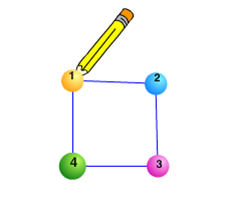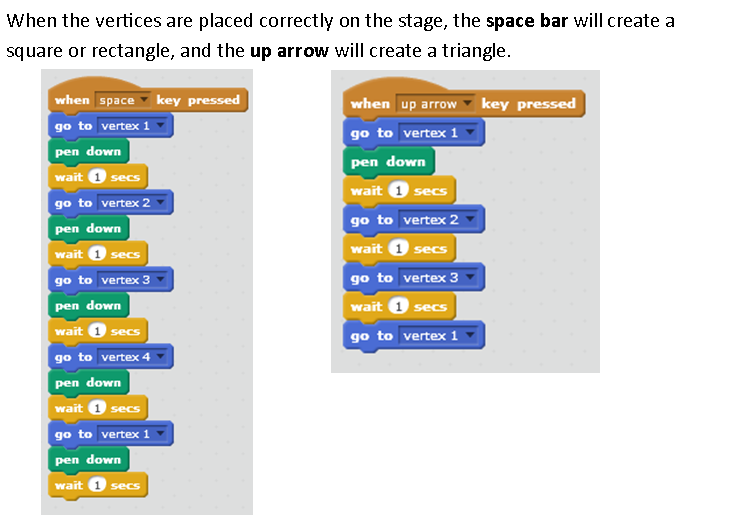
Summary:
Students use a partially completed Scratch activity to create 2-D shapes. They place the vertices for the shape on the stage. Then they change the script for the pencil sprite to make it draw segments from one vertex to the next, until it completes the shape.
Materials:
- Link to the Shapes Using Vertices Scratch activity.
- Copies of the Polygon Worksheet
- Classroom and Student computers
Programing Skills with Scratch:
- Open, remix, and save a Scratch activity
- Place sprites on the stage
- Use the correct sequence for blocks
- Use pen down, pen up and clear blocks correctly
- Use the go to block to move one sprite to another sprite’s location
- Use a drop down menu to create new Event blocks
- Scratch blocks used: (When space key pressed, pen up, pen down, clear, go to __, wait, When up arrow pressed)
Lesson:
- Open the Shapes Using Vertices Scratch activity.
- Look at the script for the pencil. When the space bar is pressed, the pencil traces a segment from vertex 1, to vertex 2, to vertex 3, to vertex 4, and back to vertex 1.
- Place the first four vertices correctly on the stage so that when the space bar is pressed, the pencil traces a segment from vertex to vertex to make a square or rectangle.
- Ask what changes are needed to the script so that the pencil sprite will go from vertex to vertex to make a triangle, pentagon, hexagon, heptagon, or octagon.
- Allow time for students to open and remix the activity.
- Pass out the Polygon Worksheet. Ask students to change the pencil’s scripts so that it makes each shape listed on the worksheet. Students should also complete the chart on the worksheet.
- Allow time for students to share their activities.
Extensions:
- Instead of only using the when space key pressed, encourage students to use the drop down menu found on that block. By using other events shown in this menu, they can keep all the scripts they create for each polygon in the script area. Then they will just need to place the vertices on the stage and use the correct Event block to create a polygon. Their scripts might look like these for a square and a triangle.

Accommodations:
- If completing all 6 shapes shown on the Polygon Worksheet is too much for some students, allow them to complete a fewer number of shapes.
- Allow for some error when students place the vertices on the stage. They may not be located at precisely 90 degree angles.
Optional Unplugged Activity:
- Dot to Dot activity.
Supplies needed for this activity:
- Paper, glue, and pencils or markers
- Lots of dots cut from a three hole punch
Directions:
- Pass out dots to each student. Call these vertices.
- Ask student to glue the vertices on their paper to make a square, rectangle, triangle, or other polygons of your choice.
- Ask students to connect the vertices to complete the shapes.
Common Core:
2.GA.1, 2.GA.2, 2.OA.C.4
CT/CS Standards:
CT—Decomposition, Pattern Recognition
CS—Understand that algorithms are implemented as programs on digital devices, Understand that programs execute by following precise and unambiguous instructions, Debug simple programs, Use logical reasoning to predict the behavior of simple programs.





These lessons were written by Judy Rocke based on lessons developed at Kenwood Elementary School in the Champaign Unit 4 school district. Funding was provided by the National Science Foundation under award number 1542828. These lessons are intended to be used alongside the EM-4 curriculum.
Lessons prepared as web documents in Summer 2017. Contact us for updated lesson plan materials.
Lessons prepared as web documents in Summer 2017. Contact us for updated lesson plan materials.
